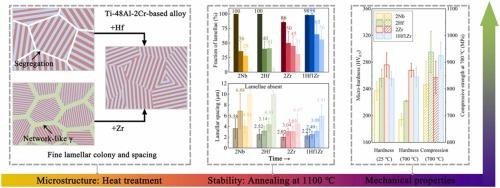Mechanistic insights into alloying-induced microstructural evolution and stability of TiAl alloys
IF 6.3
2区 材料科学
Q2 CHEMISTRY, PHYSICAL
引用次数: 0
Abstract
The drive for higher service temperatures, together with advances in additive manufacturing (AM), motivates efforts to improve the high-temperature microstructural stability of TiAl alloys. This study investigates the mechanisms by which Hf and Zr additions affect the formation and stability of lamellar structures at 1100 °C, as well as their impact on the mechanical properties of a Ti-48Al-2Cr-based alloy (at. %), using a 2Nb-containing alloy as a reference. Hf alloying alone refined the lamellar structure and enhanced compressive strength at 700 °C for as-homogenized TiAl alloy. However, it also intensified Cr segregation, which facilitated the formation of coarsened γ phase via the B2 phase during annealing at 1100 °C. Zr alloying produced the finest lamellar colonies and spacing in the as-homogenized alloy, yet it promoted an undesirable network-like γ structure prone to cracking under load. Notably, the combined Hf+Zr addition mitigated these adverse effects, yielding an optimal balance of hardness, high-temperature strength, and structural stability. The exceptional thermal stability of the Hf- and Zr-co-alloyed TiAl alloy is attributed to a higher equilibrium α-phase fraction at 1100 °C, a reduced driving force for phase transformation due to lattice distortion, and decreased diffusion coefficients and α₂/γ interfacial energy. Although the materials were produced by casting and controlled heat treatments, the 1100 °C anneal reproduces the thermal environment encountered in AM builds. Accordingly, these mechanistic insights and alloying guidelines identified here are directly informative for tailoring TiAl alloys to withstand AM-related thermal histories.

合金诱导TiAl合金显微组织演变及稳定性的机理研究
对更高使用温度的需求,以及增材制造(AM)技术的进步,促使人们努力提高TiAl合金的高温显微组织稳定性。本研究探讨了Hf和Zr的加入对1100 ℃下ti - 48al - 2cr基合金片层结构形成和稳定性的影响机制,以及它们对合金力学性能的影响。 %),使用含2nb的合金作为参考。在700 °C时,单独添加Hf合金可细化TiAl合金的片层组织,提高合金的抗压强度。但在1100 ℃退火时,Cr偏析加剧,有利于通过B2相形成粗化的γ相。Zr合金在均匀化合金中产生了最细小的片层集落和间距,但在载荷作用下形成了易开裂的网状γ组织。值得注意的是,Hf+Zr复合添加剂减轻了这些不利影响,获得了硬度、高温强度和结构稳定性的最佳平衡。Hf-和zr -共合金TiAl合金具有优异的热稳定性,主要原因是在1100 ℃时α-相平衡分数较高,晶格畸变导致相变驱动力降低,扩散系数和α 2 /γ界面能降低。虽然材料是通过铸造和控制热处理生产的,但1100°C的退火再现了增材制造中遇到的热环境。因此,这里确定的这些机理见解和合金指南可以直接为定制TiAl合金提供信息,以承受am相关的热历史。
本文章由计算机程序翻译,如有差异,请以英文原文为准。
求助全文
约1分钟内获得全文
求助全文
来源期刊

Journal of Alloys and Compounds
工程技术-材料科学:综合
CiteScore
11.10
自引率
14.50%
发文量
5146
审稿时长
67 days
期刊介绍:
The Journal of Alloys and Compounds is intended to serve as an international medium for the publication of work on solid materials comprising compounds as well as alloys. Its great strength lies in the diversity of discipline which it encompasses, drawing together results from materials science, solid-state chemistry and physics.
 求助内容:
求助内容: 应助结果提醒方式:
应助结果提醒方式:


